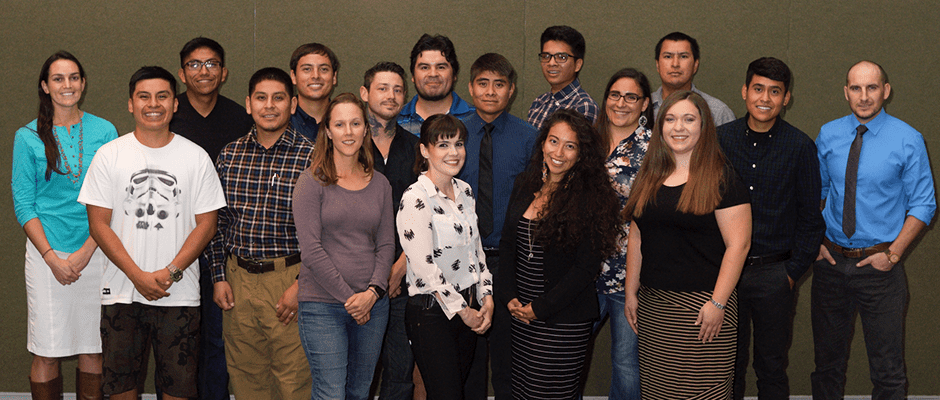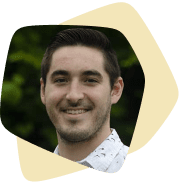Share this article
Native students find opportunities through TWS, WG program
Sixteen students stood up and introduced themselves one by one as the entire room looked on intently. They came from different universities, different tribal affiliations and even different countries. But as they addressed TWS Council at the Annual Conference in Raleigh, North Carolina, it was more important what they had in common.
All are Native American, Native Hawaiian or First Nation students pursuing careers in natural resources who attended the 2016 TWS conference as part of the Native Student Professional Development Program (NSPD). And all have incredible potential to make contributions to the profession, says program coordinator Dr. Serra Hoagland.
“These students are our future and we have no doubt in our minds that Indian country, TWS and the natural resource professions are in good hands,” Hoagland said during the Wednesday morning Council Meeting in Raleigh. “Bringing them in to TWS’ national network of wildlife professionals and helping them identify issues and solve complicated problems related to wildlife conservation really has a lot of potential to pay out.”
The NSPD program is an effort by TWS and the Native Peoples’ Wildlife Management Working Group (NPWMWG) to combat the lack of ethnic and cultural diversity within the wildlife profession. The Society and the working group believe the program can increase diversity and grow the profession, which is essential to meeting the nation’s conservation challenges. Interest in wildlife careers is growing among indigenous students, and since its inception in 2006, the program has provided 95 students with professional development opportunities.
Participants in the program receive travel grants to help cover registration fees, lodging, meals and transportation to attend and participate in the Annual Conference. They also receive a one-year membership in TWS and become members of the Native Peoples’ Wildlife Management Working Group. As TWS members they receive all the associated benefits, including The Wildlife Professional, the weekly eWildlifer, access to the TWS Network Online Directory (launching in December), and free online access to all TWS journals (effective Jan. 1).
This year, the program was funded by the U.S. Fish and Wildlife Service, U.S. Forest Service, USDA-APHIS National Wildlife Research Center and the Shakopee Mdewakanton Sioux Community. The NPWMWG previously expressed to Council in a letter that while this is a great program, it is difficult to fund alone. Hoagland says they’ve had much more success the past few years with TWS Business Solutions and Development Manager Chuck Shively helping to fundraise. Next year, they plan to look for funding from corporations in addition to tribes and government agencies.
With 16 students, this year’s group was larger than usual, but very tight-knit, according to Hoagland. They sat together at the plenary or keynote sessions each morning, attended the NPWMWG meeting where they provided input for the 2017 Annual Conference in Albuquerque, and hosted a dinner during which each student gave a 3-5 minute presentation on their culture, recent field work or jobs, and proposed research.
Alana Wilcox, a member of the Métis Nation and Ph.D. student at the University of Manitoba, had the opportunity to volunteer at the conference last year in Winnipeg, but says attending the conference as part of the NSPD program was quite different. “In this case, having the chance to interact with other students from a diversity of backgrounds allowed us to learn from each other, not only with regard to what we’re studying, but also our personal experiences in the wildlife profession,” she said.
Northern Arizona University undergraduate student Bryan Begay is a member of the Navajo Nation who participated in the program and spoke highly of his conference experience.
“I can’t stress enough on how rejuvenating it was to be surrounded by wildlifers who had the same passions, sentiments and ideas,” Begay said. “My advice to other native students is to apply for the program. Put yourself out there and get to experience the wonderful things that the wildlife professional can offer.”
For others, like Talbrett Caramillo, the NSPD program provides inspiration for students who aren’t sure of the direction of their future. Camarillo is a member of the Jicarilla Apache Nation attending San Juan College in Farmington, New Mexico. Prior to being accepted in the program, he had been considering taking a few semesters off from school and then deciding whether he should continue. “I just felt isolated,” Caramillo said. “I haven’t met students here on campus that are really pursuing anything in wildlife. [The NSPD program] gave me a chance to step back and really kind of ask myself whether or not this is what I want to do, but being accepted is a big sign telling me to keep pursuing wildlife and stay in school.”
Laura Lagunez, a Navajo Nation and Nahua Indian student at Cornell University, is one of two second-year participants in the program. Lagunez took much initiative this year, putting together a webpage for the program and even participating in the panel discussion Handling Microaggressions in the Workplace. Both Lagunez and Chase Voirin—the other second-year participant—served as peer-to-peer mentors to the other students, Hoagland says.
Each student had his or her own unique experiences, but all shared the one similar sentiment: fellowship. Rooming together, sharing meals and even attending talks together facilitated comradery, as Wilcox pointed out. Friendships were made and many of the students continue to keep in touch via email or other online mediums. Among the students there is an overarching tone of fulfillment in the wake of the conference, both professionally and personally.
“Our NSPD students feel welcomed here,” said Hoagland, who joined TWS after participating in the NSPD program in 2010. “TWS is moving in the right direction and we look forward to continued efforts on increasing diversity within our profession at the 2017 TWS meeting.”
2016 Native Student Professional Development Program participants
Ashley Archer
Sault Ste. Marie Tribe of Chippewa Indians
Michigan State University
Undergraduate Fisheries and Wildlife
Bryan Begay
Navajo
Norther Arizona University
Undergraduate
Forestry with a certificate in Wildlife Ecology and Management
Daniel Bird
Santo Domingo Pueblo
Purdue University
Graduate
Forestry and Natural Resources
Kyle Bobiwash
Mississauga First Nation (Ojibway)
Simon Fraser University
Graduate
Pollinator Agroecology
Celina Gray
Blackfeet and Little Shell Chippewa
Salish Kootenai College
Undergraduate
Wildlife and Fisheries Biology
Laura Lagunez
Navajo Nation and Nahua Indian
Cornell University
Undergraduate
Animal Science
Grant Real Bird
White Mountain Apache
Arizona State University
Undergraduate
Environmental and Resource Management
Brett Charles Stevenson
Ninilchick Village Tribe
Salish Kootenai College
Undergraduate
Wildlife and Fisheries
Chase Voirin
Navajo
University of Arizona
Graduate Wildlife Management and Conservation
Ty Werdel
Sisseton-Wahpeton Oyate (South Dakota)
South Dakota State University
Graduate
Wildlife Sciences
Alana Wilcox
Manitoba Métis Federation, Prairie Buffalo Local
University of Manitoba
Graduate
Biological Sciences/Zoology
Brissa Christophersen
Native Hawaiian
Humboldt State University
Undergraduate
Wildlife Conservation & Management
Harlan Tso
Navajo
Northern Arizona University
UndergraduateWildlife Management
Xavier Lovato
Cochiti/Santo Domingo Pueblo
New Mexico State University
Undergraduate
Wildlife Science
Talbrett Caramillo
Jicarilla Apache Nation
San Juan College
Undergraduate
Biology
Jacob Riley
Laguna Pueblo
New Mexico State University
Undergraduate
Wildlife Science
Header Image: Front row (left to right): Paige Schmidt (NSPD mentor and NPWMWG sec/tres), Alana Wilcox, Laura Lagunez, Ashley Archer. Middle row (left to right): Xavier Lovato, Daniel Bird, Brett Charles Stevenson, Bryan Begay, Celina Gray, Jacob Riley, Ty Werdel. Back row (left to right): Serra Hoagland (NSPD Program coordinator, NPWMWG Chair Elect), Talbrett Caramillo, Chase Voirin, Kyle Bobiwash, Grant Real Bird, Harlan Tso. Not pictured: Brissa Christophersen








